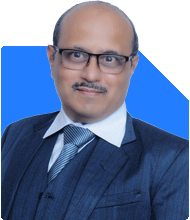Will my savings of Rs. 93 lakhs, salary of Rs. 1.9 lakhs and current investments be enough for a comfortable retirement at 58?
Ramalingam Kalirajan |10893 Answers |Ask -Follow
Mutual Funds, Financial Planning Expert - Answered on Feb 17, 2025
He has an MBA in finance from the University of Madras and is a certified financial planner.
He is the director and chief financial planner at Holistic Investment, a Chennai-based firm that offers financial planning and wealth management advice.... more

I need a good financial planning for my retirement at 58-60, salary is 1.9 lakhs ,inthis 21k carloan for another 2.5 yrs, 35k in SIP,50k monthly expenses, rent 19k , have own house in native. Have FD 65 lakhs sbi, fd in sriram 13 lakhs, in motilal oswal IAP of 10 lakhs, invested in hdfc sanchay lus for 1 lakh another 5 years to get guaranteed 1 lakh after 6 yrs , and another guaranteed plan of 60 k from next year ( both I will get for another 25 years) , sbi MF 10 lakhs ,ulip matured running for another 10 years 8 lakhs, Daughter's marriage plan after 5 yrs and son in btech from this year. Pls adv.
Current Financial Overview
Your income is Rs 1.9 lakhs per month.
Major expenses: Rs 50k household, Rs 19k rent, Rs 21k car loan (for 2.5 years).
You invest Rs 35k monthly in SIPs.
Significant assets include FDs, mutual funds, insurance, and guaranteed plans.
Retirement Planning Strategy
Optimising Investments
Your SIPs are well-structured. Consider increasing them once the car loan is over.
FDs provide safety but lower returns. You may shift part of them to better options.
Guaranteed plans provide fixed income but might not beat inflation.
Your mutual fund holdings should be diversified across equity and debt.
Managing Existing Loans
The car loan will be cleared in 2.5 years, increasing monthly savings.
Avoid taking new loans close to retirement.
Wealth Growth for Retirement
Your guaranteed plans will provide Rs 1.6 lakh per year post-retirement.
SIPs and mutual fund investments should focus on long-term wealth creation.
Debt allocation should increase as you approach retirement.
Child’s Education and Marriage Planning
Your son’s B.Tech expenses should be planned using FDs and low-risk funds.
Your daughter’s marriage in 5 years requires liquidity planning. Part of your FDs can be allocated here.
Final Insights
Increase SIPs once your loan is cleared.
Balance safety and returns by adjusting your asset allocation.
Ensure your guaranteed plans do not restrict liquidity.
Keep emergency funds accessible for unforeseen needs.
Plan tax-efficient withdrawals post-retirement.
Best Regards,
K. Ramalingam, MBA, CFP,
Chief Financial Planner,
www.holisticinvestment.in
https://www.youtube.com/@HolisticInvestment
Wishing you success and peace of mind in your financial journey! ????
Best Regards,
K. Ramalingam, MBA, CFP
Chief Financial Planner
www.holisticinvestment.in
https://www.youtube.com/@HolisticInvestment
IAP fees are higher, reducing net returns over time.
MFDs with CFP credentials help in goal-based planning, asset allocation, and tax efficiency.
Mutual funds provide diversification, professional management, and liquidity.
For long-term growth, actively managed funds under expert guidance can outperform costly advisory portfolios.
Best Regards,
K. Ramalingam, MBA, CFP
Chief Financial Planner
www.holisticinvestment.in
https://www.youtube.com/@HolisticInvestment
You may like to see similar questions and answers below
Ramalingam Kalirajan |10893 Answers |Ask -Follow
Mutual Funds, Financial Planning Expert - Answered on Jun 20, 2025
Ramalingam Kalirajan |10893 Answers |Ask -Follow
Mutual Funds, Financial Planning Expert - Answered on Aug 02, 2025
Nitin Narkhede |113 Answers |Ask -Follow
MF, PF Expert - Answered on Dec 15, 2025
Nitin Narkhede |113 Answers |Ask -Follow
MF, PF Expert - Answered on Dec 15, 2025
Ramalingam Kalirajan |10893 Answers |Ask -Follow
Mutual Funds, Financial Planning Expert - Answered on Dec 15, 2025
Ramalingam Kalirajan |10893 Answers |Ask -Follow
Mutual Funds, Financial Planning Expert - Answered on Dec 15, 2025
Radheshyam Zanwar |6746 Answers |Ask -Follow
MHT-CET, IIT-JEE, NEET-UG Expert - Answered on Dec 15, 2025
Ramalingam Kalirajan |10893 Answers |Ask -Follow
Mutual Funds, Financial Planning Expert - Answered on Dec 15, 2025
Ramalingam Kalirajan |10893 Answers |Ask -Follow
Mutual Funds, Financial Planning Expert - Answered on Dec 15, 2025
Ramalingam Kalirajan |10893 Answers |Ask -Follow
Mutual Funds, Financial Planning Expert - Answered on Dec 15, 2025
Samraat Jadhav |2508 Answers |Ask -Follow
Stock Market Expert - Answered on Dec 15, 2025
Ramalingam Kalirajan |10893 Answers |Ask -Follow
Mutual Funds, Financial Planning Expert - Answered on Dec 15, 2025






















